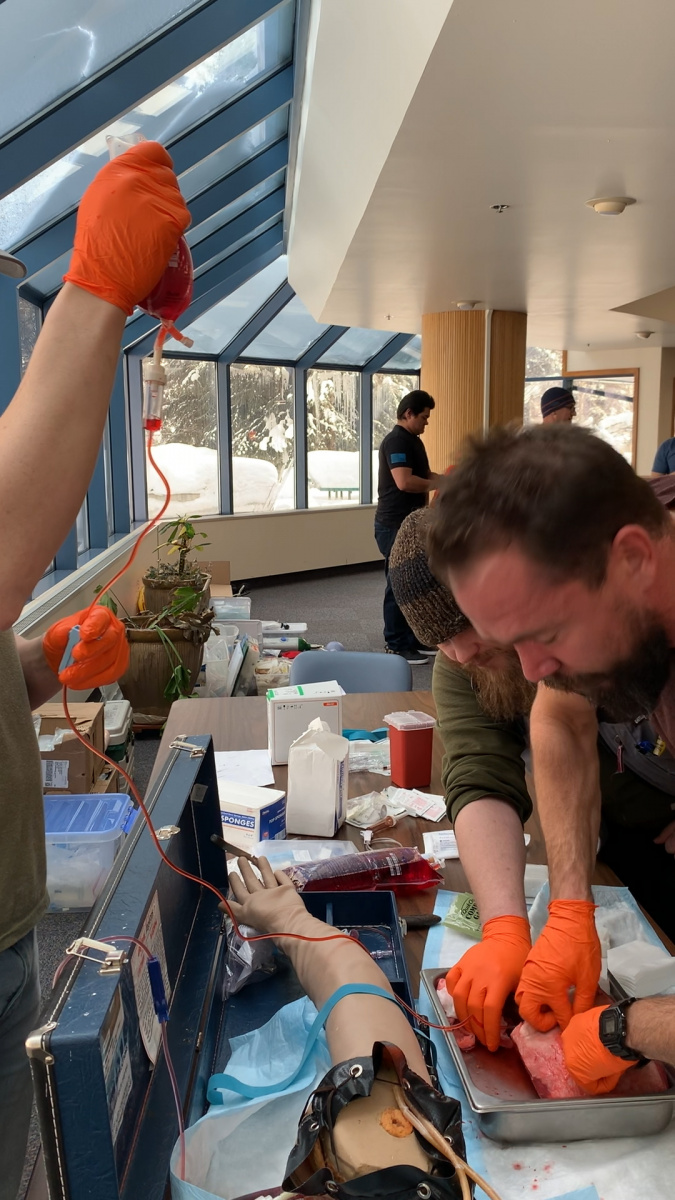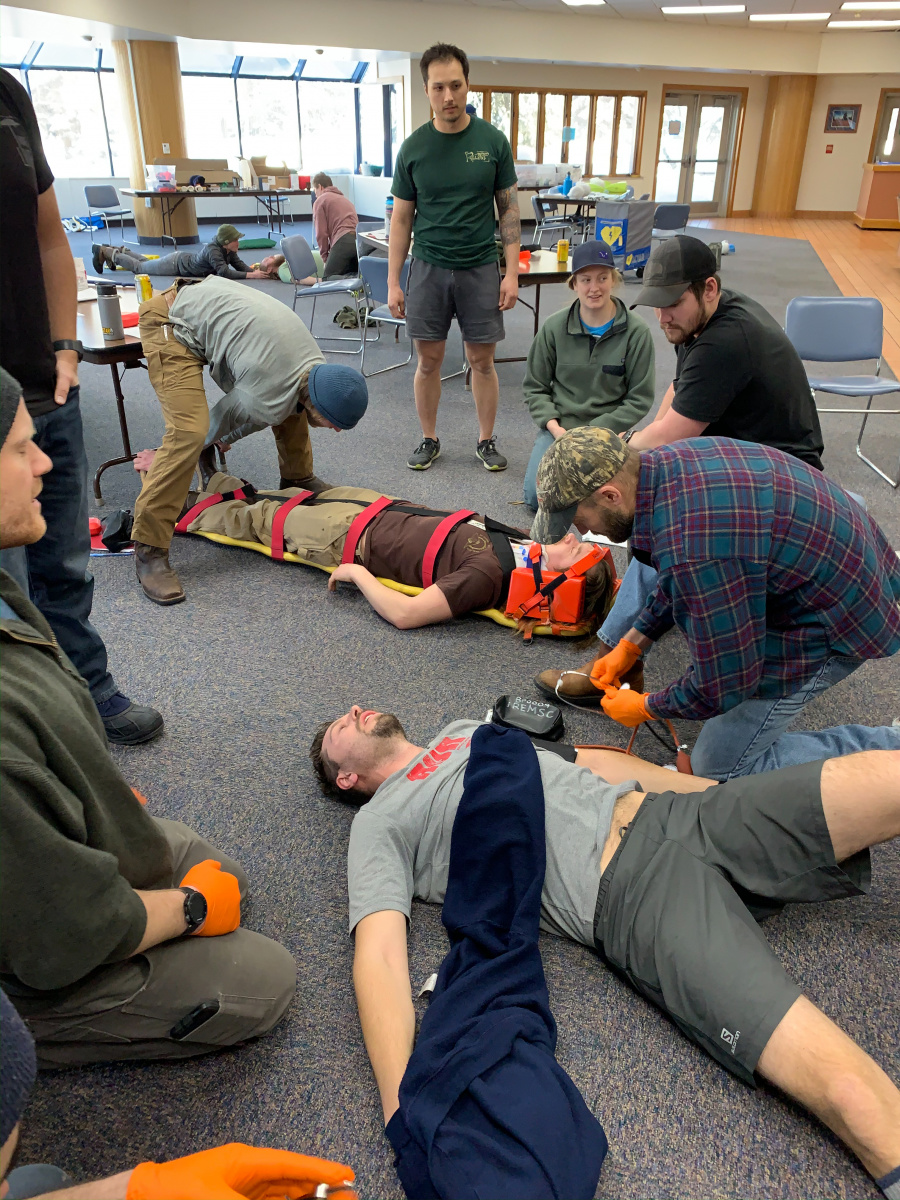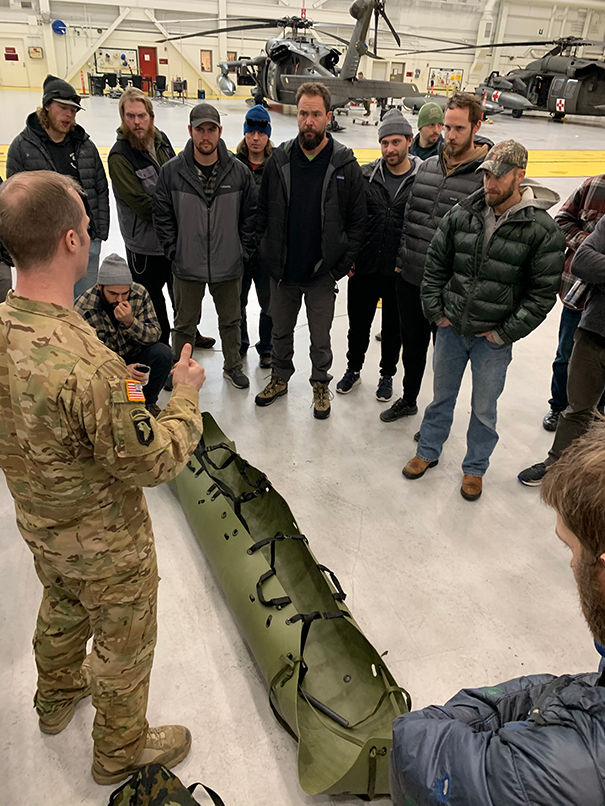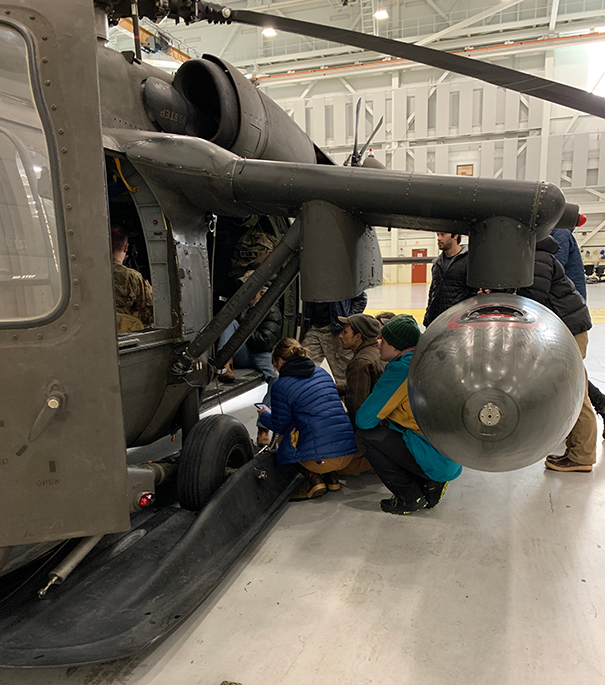You are viewing ARCHIVED content published online before January 20, 2025. Please note that this content is NOT UPDATED, and links may not work. Additionally, any previously issued diversity, equity, inclusion or gender-related guidance on this webpage should be considered rescinded. For current information, visit https://www.blm.gov/blog.
First line of fireline EMTs
Alaska smokejumper Keaton Shepard held an IV bag full of red liquid, while across the table, Chena Hotshot Max Ryan hunched over a raw beef roast sitting in a metal tray. Next to him, Warehouse Materials Handler Charlie Pohlman held the roast steady while Ryan frantically stuffed gauze into a hole in the roast.
The three BLM Alaska Fire Service employees were not taking cooking lessons at the AFS dining facility on March 12, 2020, but participating in basic training to become Emergency Medical Technicians. The three took turns simulating wound care by stopping the flow of blood, in this case, the red liquid running through an IV line and out a hole in the roast.

This three-week Basic EMT class is routinely offered to BLM AFS and State of Alaska wildland firefighters who may be among only a handful of people working on remote fires far from any established trauma medical services.
“Due to the nature of our job in Alaska, we have a very long transport to medical facilities,” said Kris Dudley who, as the BLM AFS Smokejumper EMT coordinator, helped coordinate the training. “Having qualified EMTs right there is critical to saving lives.”

The initial EMT training is offered at BLM AFS facilities at Fort Wainwright every other year with refresher EMT training conducted during the alternative years to keep up with skills and emerging medical treatment methods. This is separate from the Alaska Fire Medic Program which places qualified medics pulled mostly from Alaska fire department ranks for larger fires. Instead, this is a collateral duty for wildland firefighters. Having qualified and capable medical first responders among initial attack firefighters directly on the fireline is crucial to treating trauma in the field.
“We’re training our medics who are on the fireline. There’s a lot more demand for a fast response,” said Cammy Roy, who as the BLM AFS EMT coordinator for the hotshot crews, fire specialist section, and the AFS management zones, helped organize the training. This is also a collateral duty for Roy who spends most of the fire season as a wildland fire helicopter manager.
The need for having EMTs, whether it’s an extra qualification for firefighters or by having an assigned fire medic, became a national priority after a wildland firefighter suffered an injury from a felled tree on the Dutch Creek Fire in California in 2008. He died 3 ½ hours later because of delays in getting him the proper care.

Ensuring proper care in remote Alaska locations, the students take State of Alaska tests to become a certified EMT-1 upon completion of the course. They will still need to take specialized training in order to administer things such as airway management, spinal clearance, joint relocation, chest decompression, IV fluids and medication.
Both BLM AFS hotshot crews have at least one, if not two, certified EMTs among their ranks in any given year. A little less than half of the more than 60 BLM AFS smokejumpers are certified EMTs. Smokejumpers parachute near the fire with enough supplies for three days. They can even respond specifically for a medical emergency, if needed. Smokejumpers and hotshots are often the first line of defense against wildfires in much of remote Alaska.
Among those going through this training were firefighters from the Alaska Division of Forestry’s Gannett Glacier and White Mountain Type 2 initial attack crews and the Pioneer Peak Hotshots; the BLM AFS Midnight Sun and Chena Hotshot crews; seven BLM AFS smokejumpers; and Pohlman, the sole warehouse worker in the training. Because this course is a condensed version that typically lasts a semester, students had a list of preparation coursework, and then regular homework after the daily 10 hours of instruction.
With direction from Dr. Joe Livengood, the program’s medical director, and Alaska Fire Medic Program Director Jon Thomas, the red medic trauma bags that usually accompany qualified smokejumpers, AFS hotshots and AFS’s training crew, the North Star Crew, were upgraded. There were 25 new trauma bags available to test this year andRoy said the hotshots and North Star Crew were very pleased with the new trauma bag because it was light weight, allowing for easy accessibility by having it on the line and not just staged at camp or a helicopter spot. The plan is to have at least two for each crew.

BLM AFS helicopters are also equipped with trauma kits, backboards and some helicopter managers are EMT-qualified to help with the transfer of patients from a fire during the process of getting them to a medical facility.
“Our program has been growing in the past few years,” Roy said. “The hotshots, fire specialists, and AFS Zone personnel have acquired advanced skills in the last three years.”
BLM AFS smokejumper Ryan Keogh, an EMT-1 instructor for the State of Alaska, puts the course together to meet state requirements and sponsors two of the training instructors from the BLM El Central Office in California. El Centro and BLM AFS formed a partnership in the past few years that not only brings paramedics Brian Puckett and Rueben Duran from El Centro to lead the instruction in Alaska, but allows certified BLM AFS EMTs to augment El Centro staff during peak times at the popular Imperial Sand Dunes Recreation Area. BLM park rangers respond to around 400 medical and search and rescue incidents each year from October through April – off-season for many at BLM AFS – with most of these calls involving off-road vehicles. The exposure to trauma cases and search and rescues mimics what they might see in the field during fire season, giving BLM AFS EMTs the confidence to deal with a variety of different medical emergencies.
“Heaven forbid we have to deal with trauma,” Roy said. “But it gives them an idea of what to expect and think ‘okay, I can do this’ if the situation came up on the fireline.”
Beth Ipsen, Public Affairs Specialist
Related Stories
- Progress on Public Lands: BLM 2025 Trump Administration Accomplishments | January 20 - December 31, 2025
- Rural wildland firefighting partners grateful for BLM gift
- BLM Fire Team brings Smokey Bear to Kingman’s Street of Lights
- BLM hosts fire investigation training course to strengthen wildland fire investigation capacity across Arizona and the West
- Using science to uncover mysteries of the Mesa archaeological site in Alaska
Office
P.O. Box 35005
1541 Gaffney Road
Fort Wainwright, AK 99703
United States
